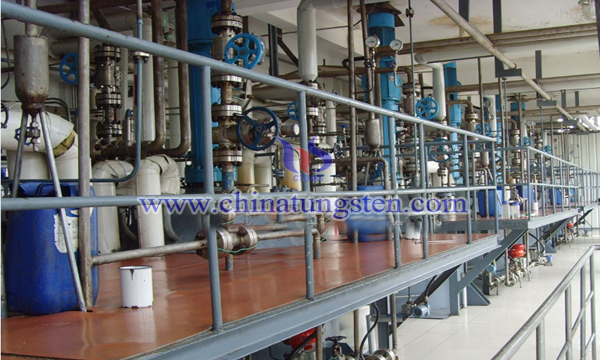Tungsten Mineral Raw Materials Decomposition by Far Infrared Hot Pressing
- Details
- Category: Tungsten Information
- Published on Saturday, 02 June 2018 10:35
In order to optimize the technological process, energy saving and emission reduction, the researchers put forward a far infrared hot press decomposition of tungsten mineral raw materials to achieve a clean production process for the full decomposition of tungsten minerals in wet tungsten smelting. The characteristics of the process are as follows:

The raw pulps formed by tungsten minerals and auxiliary materials were put in a closed and stirred reaction kettle and heated by far infrared heating to fully decompose the raw slurry under the hot pressing condition.
The reactor is a pressure vessel. The heating time was 2~5 hours and it was controlled at 170~210°C. When a higher decomposition rate is reached, the heat absorbed by different tungsten materials in decomposition process is different. For some easily decomposed tungsten materials, it is not necessary to set a high final temperature. The temperature of wolframite concentrate, especially manganese tungstate, needs to be above 195°C, the temperature of the floatation of scheelite concentrate is only 170°C. If a large amount of tungsten powder or tungsten thin mud is added, the decomposition temperature can be reached to 200°C to guarantee the ore decomposition rate.
For example, treating wolframite concentrate, the slurry 6m3 (2.5 tons of ore, WO3 grade 69.48%, NaOH concentration 130g/l, Na3PO4 concentration 13.8g/l) is decomposed by far infrared hot pressing. The final reaction control temperature is 193°C, and the reaction is 19.2 g/l, the concentration of WO3 is 0.82% after slag filtration, and the weight of slag is about 1 ton.
Using the new heating method, the reaction temperature is high enough to achieve the full decomposition of tungsten mineral materials in less time with less auxiliary materials. In this way, the processing capacity of the monomer unit is more than 5 times larger than that of the conventional reactor. It not only makes full use of the characteristics of the material in the process, optimizes the process process, but also improves the WO3 recycle rate of the ore decomposition, reduces the consumption of auxiliary materials, and reduces the actual energy saving and emission reduction.
- Tungsten Manufacturer & Supplier, Chinatungsten Online: www.chinatungsten.com
- Tungsten News & Prices of China Tungsten Industry Association: www.ctia.com.cn
- Molybdenum News & Price: news.molybdenum.com.cn
- Tel.: 86 592 5129696; Fax: 86 592 5129797; Email: sales@chinatungsten.com



 sales@chinatungsten.com
sales@chinatungsten.com